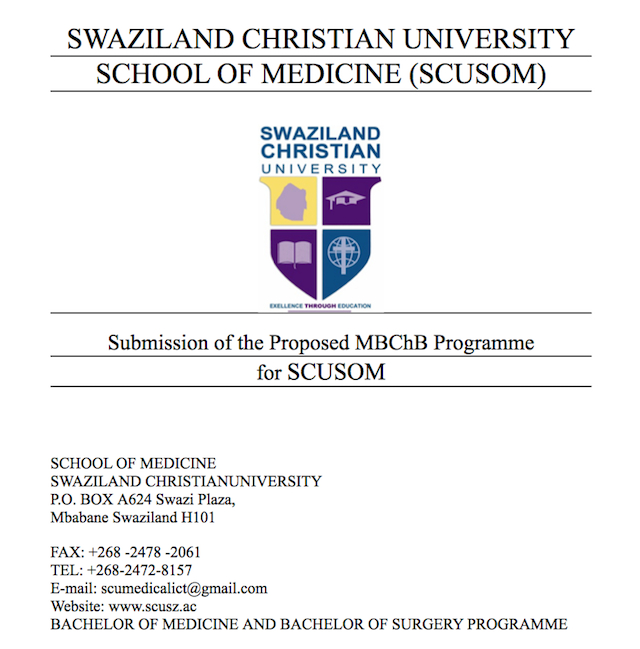스와질랜드 기독대학교(Swaziland Christian University)는 2015년 8월에 의과대학을 개교한다. 그동안 준비해오신 분들의 기도와 땀으로 스와질랜드에 의과대학이 만들어지는 것이다. 이 때 새학기가 시작되면 2학기인 2016년 1월에 “인체의 구조와 기능(The Strucutre and Function of Human Body)에 대한 강의가 시작될 것이다.
지난 주(11월 첫째 주)에는 함께 해부학을 강의해 줄 Y의과대학의 C교수님으로 부터 전화가 왔다. 조만간에 전주에서 만나서 해부학 교육과정에 대한 전반적인 논의를 할 것으로 보인다. 또한 우리대학의 K모 교수님께서 생리학을 강의해 주시기로 하셨다. 짦은 시간에 많은 것들이 정리되고 있다. 아마도 현지에서 일하시는 분들에겐 큰 힘이 되는 소식일 듯 싶다.
특히 내가 맡아야 할 부분이 정해지면 그 부분에 대한 학습목표와 졸업성과, 강의내용 등에 대한 더 구체적인 교육과정에 대해 정리를 해야 할 것으로 보인다. 그 다음이 영어강의를 준비하는 일이다. 해부학은 인체의 구조를 설명하는 학문이기 때문에 그리 어려운 영어를 쓰는 것은 아니지만, 영어로 생각하고 영어로 말해야 하는 영어강의가 내게는 큰 부담인 것은 사실이다.
그러나 기꺼이 하기로 한 것 열심히 준비해 보려고 한다.
우리대학의 J모 교수님은 현재 스와질랜드를 방문중이다. 평소에 철저한 신앙생활을 하시는 교수님께서 현지를 방문해서 여러가지를 보고 점검하는 차원일 것으로 보인다. 다녀오시면 뭔가 이야기를 해주실 것으로 기대하고 있다.
앞으로 스와질랜드의 이야기가 어떻게 진행될지 나는 모른다. 그러나 하나씩 하나씩 진행되어가는 모든 일들을 기록하고자 한다. 어떤 미래의 성취에 대한 것을 적으려고 하는 것은 아니다. 이 일이 열매를 맺을 수도 그렇지 않을 수도 있다. 다만, 모든 과정을 적어놓음으로서 우리의 인생을 다시금 되돌아 볼 수 있는 기회의 시간들이 될 것이기 때문이다.
특히 열악한 환경인 현지에서의 대학설립에 이은 의과대학의 설립이 그리 호락호락하지는 않을 것이다. 그렇지만 그 땅에 “복음의 빚”을 갚는 일은 매우 중요한 일이다. 그 일을 위해 수많은 사람들이 애쓰고 있다. 그 일에 조금이나마 힘이 되었으면 하는 것이 내 바램이다. 내가 할 수 있는 것을 할 수 있다는 것이 내게는 기쁜 일이다. 아직까지 아무것도 한 일이 없지만, 앞으로 열심히 준비해서 조그마한 힘이라도 보탤 수 있기를 소망하는 것이다.
스와질랜드 기독대학에서 온 교육과정 중 해부학과 생리학에 해당되는 부분은 아래와 같다.
FOM1201. INTRODUCTION TO STRUCTURE AND FUNCTION OF THE HUAN BODY
COURSE DESCRIPTIONS :
Introduction to Anatomy: anatomical position, branches of anatomy Normal structural relationships in human body; Anatomical terminology, osteology, embryology and histology; Homeostasis; The nervous system structure and function Basic anatomy of the skeletal system; Skeletal muscle morphology; Skeletal muscle function; Muscle physiology; Smooth muscle: structure and function; The structure and functions of the skin and mucous membranes; The respiratory system structure and function Structure of the heart and blood vessels ; Variations and congenital malformations.
COURSE OBJECTIVES and CONTENT OUTLINE :
- Use the correct medical terminology appropriately.
- Appropriately relate knowledge of anatomy and physiology to medical examples.
- Competently detail the anatomy of the human body, relating it to normal structure and function.
- Histological processes and structures are well described and a holistic view is presented.
- Processes of physiological control are discussed, and an integrated view is presented to show how the body maintains homeostasis Systems, such as those of the nervous, skeletal, the skin and mucous membranes, respiratory, and cardio-vascular are aptly described and discussed in detail with regards to anatomical structures, physiological processes, and the normal and disease states.
- Developmental abnormalities that may result in malformations evident at birth and their causes are described and explained.
EXPECTED OUTCOME :
The student will be able to:
- describe and illustrate the normal layout of the body structures and how they relate to each other (anatomical relations).
- identify various anatomical structures and discuss how they relate to others. Explain the processes responsible for normal function.
- integrate the knowledge on anatomy and physiology to appraise disease state.
METHODS OF DELIVERY :
Seminars, Independent Learning, Small tutorial sessions with a tutor
ASSESSMENT METHODS :
Formative assessment methods include observation methods, oral questions, practical exercises and demonstrations, self-assessment and peer reviews as well as tests. Not all formative assessments are scored, but feedback is provided. Summative assessment methods comprises of an end of year written examination paper.
- 60% Formative Assessment Mark
- 40% Summative Assessment Mark
- Assignment 1 : 300 word letter (1-3 paragraphs), written from the point of view of a doctor raising a question about medical records security.
- Assignment 2 : 1000 word report (about 1 and a half pages) on an aspect of telemedicine.
- Assignment 3 : Creating a dynamic web page comparing medical images.
- Assignment 4 : 1200 word essay (ca 2 pages) comparing two approaches to a medical computing problem.
COURSE DURATION : 8 weeks (56/lecture hours, 16/tutorial hours, 32/practical hours, 80/self-study hours, 120/clincal exposure)
RESOURCES AND INFRASTRUCTURE AVAILABLE : Internet sources on Computer science


